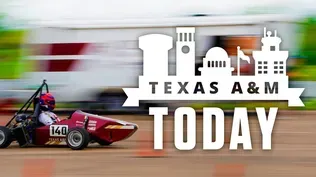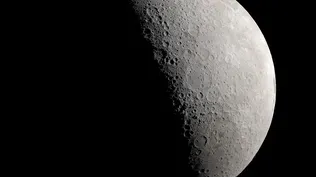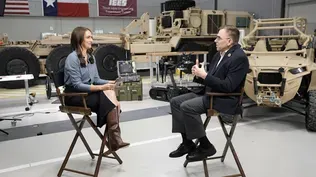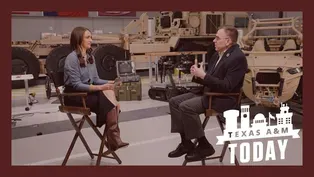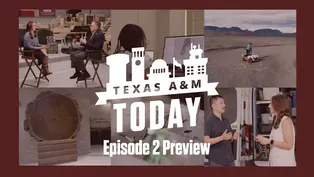
Ep. 2 - Innovation at Texas A&M
Season 2 Episode 2 | 29m 35sVideo has Closed Captions
Learn how Aggies continue to lead the way in innovating for a better future.
In Episode 2, learn how A&M is paving the way for the future of space exploration and research. See how recent advancements in AI and 3D printing technology impact a range of fields. Find out what is in the air we breathe, and check out an on-campus California redwood that is actually older than the Century Tree. Plus, watch a Q&A with Tim Green, Director of the Bush Combat Development Complex.
Problems with Closed Captions? Closed Captioning Feedback
Problems with Closed Captions? Closed Captioning Feedback
Texas A&M Today is a local public television program presented by KAMU

Ep. 2 - Innovation at Texas A&M
Season 2 Episode 2 | 29m 35sVideo has Closed Captions
In Episode 2, learn how A&M is paving the way for the future of space exploration and research. See how recent advancements in AI and 3D printing technology impact a range of fields. Find out what is in the air we breathe, and check out an on-campus California redwood that is actually older than the Century Tree. Plus, watch a Q&A with Tim Green, Director of the Bush Combat Development Complex.
Problems with Closed Captions? Closed Captioning Feedback
How to Watch Texas A&M Today
Texas A&M Today is available to stream on pbs.org and the free PBS App, available on iPhone, Apple TV, Android TV, Android smartphones, Amazon Fire TV, Amazon Fire Tablet, Roku, Samsung Smart TV, and Vizio.
Providing Support for PBS.org
Learn Moreabout PBS online sponsorshipThe Texas A&M Today Show is made possible thanks to Grow College Station - Howdy from Texas A&M.
We're on a mission to find the best and brightest at Texas A&M, taking you behind the scenes of one of the nation's largest universities.
In today's episode, Texas A&M leads the way in researching some of the most pressing issues of our time.
- [Dr. Tracy] As AI gets smarter, it's even more important to make sure to have the human in the loop.
- [Dr. Patrick] People are exploratory by nature.
They want to be explorers.
They're never satisfied.
- [Dr. Yue] It really brings our research capability from Texas A&M to a new level that has not been done before.
- Welcome to campus.
Welcome to "Texas A&M Today."
Howdy, I'm your host, Chelsea Reber.
Today, I'm at the Bush Combat Development Complex on the Texas A&M RELLIS campus.
This brand new facility helps lead our military forward.
Stay tuned for more about it near the end of this episode.
Aerospace engineers often get much of the credit for the mind-blowing work that goes into space flight, but Texas A&M is spreading the wealth.
Interdisciplinary efforts are taking A&M's impact on space travel further than ever before with more than 300 research projects happening across campus.
Because to truly succeed in space, we need everyone, including engineers, geologists, and construction scientists.
(gentle music) - Anytime anybody sees a launch, it's incredibly inspiring.
You know, all this engineering that comes together to do something miraculous all in one second, it really blew me away.
And I could never have imagined that, you know, while I was watching rockets go to the moon as a kid, that my whole life and career would pass before we would, you know, get to go back.
- It's exciting for me to think that we will have a whole lunar space economy of building on an outpost like the moon, and then being an interplanetary species when we're able to colonize Mars with our international partners.
(gentle music continues) - I like to focus on wind, so how wind is blowing sand around on the surface, and it turns out that this is a really good place to be to also study other worlds.
So Earth, of course, has giant deserts, and these deserts have sand dunes, they produce dust.
Well, once we started exploring the solar system, what we found is that Mars, Venus, Titan, Triton, Pluto, all of these places also had evidence of wind-blown processes.
And so, there's really two places on Earth that are ideal analog environments that have processes that are operating at the surface and also have a composition that's similar to Mars, and that's Iceland and Hawaii.
I remember rolling up, you know, on the rover, seeing these first images and being stunned at the way these sand dunes looked because it was a truly alien look and it's like nothing we see on Earth.
And I think the real enigma there is that, "Boy, this is just a pile of sand.
How can it look so different?"
And it's really ignited our community.
- Space construction is part of the Artemis mission, which is the National Aeronautics and Space Administration's goal for the first woman and the next man to get back to the moon to be able to establish a lunar presence permanently there, as well as get us from a lunar support base to a Mars mission.
And so, imagine all the infrastructure that we have at an airport or at a regular terrestrial launch facility, all of those sorts of things are going to be needed to be built on the moon.
If you think about the missions that we've had there under Apollo in the past, they were very light spacecraft, there might've been one or two people, some of the later Apollo missions had rovers.
But we've never tried to pursue the type of undertaking and the type of infrastructure that we're going to be building on the moon in the next few years.
A lunar support base is gonna start with, what does it take to keep a person alive?
That takes air, it takes water, it takes shelter, and it's shelter unlike any kind of shelter that you have here.
And so, imagine walking down the sidewalk at Texas A&M but in a vacuum, in massive radiation, in negative 100 or 200-degree temperature, so people will be existing up there in a relatively semi-permanent or permanent state.
And so, all the same things we have in our towns, we'll need there.
We'll need healthcare facilities, we'll need lodging, dining, roads, infrastructure, waste treatment.
All the same things that we have in any town in Texas or in America will be built on the moon.
(light airy music) - So part of it was just the realization that everybody is excited about space, but not everybody has the opportunity to contribute.
I actually watched my kids play Minecraft and they were collaborating with their friends.
They were sitting at home on a computer, collaborating with a friend to build something who was somewhere else.
I was like, "Why can't we do that, you know, for space?"
ASTRO Lab stands for Aerospace, Technology, Research and Operations.
So we are doing a lot of different projects related to space flight.
So what we have essentially, you know, what people are calling digital twin.
What we've created here is a digital twin of the space environment, the whole solar system.
Our goal is really to make it possible for anybody who's designing anything that's gonna be in space to be able to test it in a virtual environment of space before building it and flying it, you know, actually in space.
(gentle music) - I think the main thing that we offer, at least, in this lab is accessibility.
So you can come into this lab with no experience and you can pick it up right away.
We try to offer it at a level that anybody from an incoming freshman to a PhD student can contribute something.
That's one of our main goals.
- There's so much stuff that we've done that's the highest fidelity that's done anywhere in the world and it's just really neat to be, for me, especially to be able to see things like the south pole of the moon or places on Mars that nobody's been before in like full scientific detail.
- When I think about what we're doing for space research, Texas A&M is the most uniquely situated university that has the ties to the Department of Defense that help the space launch platforms that we need here on Earth.
- The nice thing about, I think, what's happening at Texas A&M and the space arena is there's a lot of collaboration between departments.
So for example, you know, what's happening in construction engineering.
You know, I'm working with them.
We have multiple projects together, we're working on grants together.
- Texas A&M has long been a player in space studies, and the opportunity now is to leverage our historical strength and branch into some of the new aspects of of space that the community needs to understand.
- If this is the golden age of Texas A&M, what better time to align with the golden age of the second coming of the space race?
(light airy music) - Space exploration is so important to A&M that it's investing $200 million into a new space institute at the Johnson Space Center in Houston.
Former astronaut and current professor, Nancy Currie-Gregg, will lead the institute, prioritizing projects looking for practical solutions to existing problems.
Now, it's time for an "Aggie Fact."
(upbeat drum music) The Century Tree may be the most famous tree on campus, but it isn't anywhere close to the oldest.
At the Horticulture/Forest Science Building on West Campus, a massive cross section of redwood is on display in the atrium.
It's nearly six feet in diameter.
That's a few inches bigger than a large tractor tire.
Tree-ring dating puts the tree at more than 500 years old, back to the year 1476.
But how did it get here?
In 1975, Alamo Hardwoods in San Antonio needed a standout piece for their new showroom.
They bought two pieces of the same redwood, cut down by a commercial timber company and what is now part of the Redwood National Parks Complex in California.
One lives in their showroom to this day.
The other was donated to A&M in 1981 in honor of the owner's son, Class of 1969.
Bonus fact, Alamo Hardwoods supplied the wood for the 2019 Fightin' Texas Aggie Band wood carving in the new music activity center.
(upbeat music) Is there a bigger story right now than the future of artificial intelligence?
AI is solving complex problems, driving cars, writing papers, and producing art and music, but there's concern about what AI could become.
That's why researchers at Texas A&M are finding ways to use the technology for positive purposes.
After all, AI is already ingrained in our lives in more ways than we might think.
- Think back to when the calculator showed up.
People were afraid to give students the access to the calculator because they thought that will somehow reduce their learning.
Rather, it's done completely differently.
It's allowing us to go further.
Generative AI is fantastic as a tool to help teach people.
The lab is called Sketch Recognition Lab.
But really, we do anything that there's sort of a path in recognizing messy human motions.
So we started with sketch recognition and we have a couple of projects there.
We have mechanics, which will automatically correct students' homework diagrams.
And so, the idea is to be able to check not just the final answer, but to check the process.
- Everything we build has a human focus, and I think this is vitally important because you can't just be producing products.
You can't just put computing models out there in the latest and greatest technology if you're not thinking about how the person is using it.
And we very much look at it from the human side first.
It's that interaction that is important.
My application is Sketch Canvas, and what we do is we draw with young children primarily in the age range of 3 to 5, and we are collecting their drawing data of different types of simple shapes, lines, different prompts and freehand strokes to try to relate the computational aspect of sketching to the physical act of motor development and fine motor activity.
We call the work we do life recognition because a big part of AI is interpreting human activity.
And anything that is easy for humans that we take for granted, is typically hard for a computer.
Humans are messy.
So when humans are drawing or when they're writing or when they're making music, whatever it may be, to a computer, this is just messy noise until we explain how that works, until we build models that can decipher the information and learn mappings between this messy input to a clean structured output that ideally informs some new capability, some new application.
- The biggest things about AI that you have to be concerned about is biases, right?
That make its way into AI.
Whatever you put into it is what it learns.
These are wonderful, wonderful tools, but we have to be careful about the bias 'cause we need to make sure that we're not exacerbating inequalities.
You have to make sure that what the input is is balanced and you need to make sure that you're involving people from all walks of earth in the design process itself.
- [Dr. Tracy] Many jobs will go away, but different jobs will be created.
And as we develop more technology, you'd need people for more and more things.
And as AI gets smarter, it's even more important to make sure to have the human in the loop to make sure what's actually going on is logical.
- Both professors believe an important next step is creating an oversight board to establish regulations and hold AI companies accountable.
Congress seems to agree.
This year, senate committees have held multiple hearings to discuss issues involving AI.
They generally agree that it should be regulated, but they aren't sure how just yet.
The world is now home to nearly 1.5 billion cars, 10 million factories, 62,000 power plants, and around 600 to 700 refineries.
Most have one thing in common, they pollute the air, and Texas A&M is tracking the effects.
What's in the air that we breathe?
You may not wanna know, but researchers do.
That's why a team in the Atmospheric Sciences Department built this mobile lab that they drive around the state to gather data about what's in the air.
- [Dr. Yue] This mobile lab, I'm super excited about and we have been using for over a year now.
So we put all kinds of our research-grade instrument inside and then we can use this to sample different parts of air in real time.
- Dr. Yue Zhang leads this collaborative project involving atmospheric scientists and engineers.
It's the first of its kind at A&M and its rare among universities.
How many instruments are actually in the van?
- We have actually so many.
It's a little bit hard to count, but we have instruments that can measure both aerosols and gases.
We can specifically look at carbon monoxide and we can also look at nitric oxide and nitrogen dioxide and we can also look at particular matter.
All these are very important species in the air that can cause adverse health effect and affect the climate.
- Dr. Zhang and his students are able to sample thousands of pollutants every second, and they're also able to forecast future conditions.
Well, if it's okay with you, I would love to take a ride.
- Oh, absolutely.
I'm happy to take you for a ride and then we can check out all the air qualities around College Station.
- [Chelsea] Dr. Zhang drove me around College Station, showing me how they measure pollutant data.
- It can connect to all the instruments simultaneously, and then normally the people at the passenger seat will be monitoring our computer and look at all the instrument data.
So wherever we go, we can combine the concentration with the location later on when we do post-data analysis, so we know, "Oh, this area has a high concentration and then the other area has a low concentration."
- The mobile lab is driven through Aggieland, Houston, San Antonio, Dallas, and Corpus Christi.
How is the air here in Bryan and College Station compared with bigger cities?
- We do have lots of cars.
So compared with these large cities, which you have even more cars and even more industrial and personal activities, we are much cleaner than them.
But compare with forest or these rural areas, we're still relatively polluted.
- [Chelsea] Dr. Zhang says the lab's data can be invaluable to society.
Putting more information in the hands of policymakers, companies, and everyday people can help everyone make decisions about new laws or even where to live.
- We can also go into small different neighborhoods which are not possible without this van.
So we can look at very close to the house, how is the air concentration and the pollutant concentration there?
So this will really help the residents to have a safer and cleaner air and environment.
- [Chelsea] As our drive wrapped up, Dr. Zhang shared why the lab is such a good resource for the university.
- Students get a really nice hands-on experience so they can learn how to do this state-of-the-art deployment that is really rare across the whole country.
It really brings our research capability from Texas A&M to a new level that has not been done before.
- Although the mobile lab has only traveled across Texas, Dr. Zhang hopes to take it to other big cities and even emergency events such as wildfires and chemical spills.
Innovation is happening every day on campus in the area of 3D printing.
Dozens of research projects are underway with new printers, inks, and objects.
Today, we're highlighting a few that could have an effect on our everyday lives.
You'll see plastics made from salt, new surgical techniques for injured animals, and rare fossils from South Africa.
- What makes me passionate about this field is just the sheer discovery, working with bones of animals that have not been on this earth for millions of years, and you are the first person to discover them, examine them, and let the world know about them.
It's absolutely a thrilling occupation.
Things like diamonds, rubies, precious gems, there are actually a lot of them and we know where to get them and we know it's easy to find more of them.
Fossils of human ancestors are vanishingly rare.
To be able to actually discover one that no one has seen before, to go into a new area and find new things, it's a sensation of elation, but also a heavier responsibility because once you have found these fossils, you now have to do something with them.
The fossils that I work on are mostly located in South Africa.
We find them in the field, bring them out of the field, and we curate them at the University of the Witwatersrand in Johannesburg, and that's where the fossils remain.
We owe it to these fossils to do the best we possibly can to protect them for posterity and for future generations to study it.
The fossils that I'm scanning are fossils of human ancestors that I and my research team have recovered over the past 10 to 15 years.
Technology has revolutionized the study of paleoanthropology or the fossil evidence for human evolution quite dramatically.
Creating high resolution 3D models that you can scale up and down and really zoom into or zoom out of is very valuable for our field.
What we do is we take these high resolution scans that we create, and our team, my research team, we make them freely available to the public, and the public, therefore, can download these models and print them themselves at the same resolution that I can.
We don't keep better resolution models for ourselves.
We want everybody to have access to the same information.
What we're doing is trying to bring more voices into the science of paleoanthropology by putting the fossils effectively in everyone's hands.
(light music) - A lot of the times when we think about polymers, we think of plastics.
Instead of being individual small molecules like grains of salt that can flow and move past each other, they're kind of like spaghetti noodles when they've been cooked and they entangle with each other.
We use them in the world around us for everything from the plastic water bottles that we buy and then throw away to the handle on most of our hairbrushes, and then the bumpers of our cars as well.
We decided to use salt particles, so just table salt, where we grind them to much smaller particles and add those to the polymer solution.
That gives us the processability to take the polymer and solution with the salt particles, put it into the syringe, and then when we're ready, to print it and then wash away the salts and the solvent, and that gives us a solid polymer in whatever structure we've printed.
Sustainability means something different to basically everyone, but where we really wanted to go with this was to understand how we could use something like carbon dioxide to make polymers, and then once we print and use the polymers, we could then degrade them over time so they don't persist in the environment.
- I think this 3D-printed polymer could be used for things like bone regeneration.
You can imagine 3D printing something that's, for example, as stiff as bone, and then something that's more flexible like cartilage from the same base material but just by tuning the ratios of the different molecules that we add to it.
When we have the material that we know we can print and then we've determined that it is printable and we demonstrate printability using our printer, I'd say that's the breakthrough when we know, "Okay, everything is gonna be okay and it's going to work well."
- My name is Kate Barnes, and I'm a clinical associate professor of small animal orthopedic surgery at Texas A&M University.
I think 3D printing has a lot of really great applications in veterinary medicine, and being able to bring that in, I think, can really increase our quality of care to our patients.
3D printing is used in veterinary medicine, but definitely not as much as in human medicine.
I would say some of the simplest things that we can use 3D modeling for are if we have a complex fracture or an angular limb deformity and we just wanna get a better visual representation of what's going on.
We can create a virtual 3D model on a computer and just be able to see that deformity and see that fracture can help with planning and preparing for surgery.
In terms of the planning phase of surgery, we can use 3D printings to just get a little bit better idea of what's going on.
I think the future of 3D printing in veterinary medicine, I hope, is going to be big.
And I think over the past couple years, it's really been increasing in popularity as people realize some of the benefits that can come from it.
Being able to bring that into our, kind of, our repertoire of things that we can offer patients at Texas A&M, I think, is really cool.
I'm happy to be a part of that process.
- 3D printing isn't just for faculty.
A&M has invested serious money into dozens of printers available for student use across campus.
Next, I caught up with a Texas A&M difference maker for a one-on-one conversation.
Today, that's the director of the Bush Combat Development Complex, Tim Green.
Major General Green served in the U.S. Air Force for more than 30 years after graduating from the ROTC program at Texas A&M.
What drew you to engineering?
- So I was good at math and science, that's the first thing.
I loved solving problems, competing in games, taking things apart.
And then lastly, I knew I couldn't make it as a professional musician, although I would liked to have tried.
But that's really what drew me in.
- What assignments during your military career are the most memorable?
- The seminal moment in my career is really 9/11.
I served with General John Jumper, the chief of staff of the Air Force at the time, so I was in the Pentagon.
And after the planes went in the World Trade Center, we were literally changing our footing from a peacetime footing to a wartime footing when the planes went in the Pentagon.
I'll never forget the sight.
It was a beautiful day.
I mean, it was a phenomenal fall day.
You look down and you see the Pentagon on fire, the Wedge collapsed, all the emergency responders.
I resolved to stay and serve as long as I thought I could be helpful to try to prevent something like that, do my part to prevent something like that from happening again.
- While you were in the Air Force, you saw the tools and the equipment that our airmen and women use every day, and you know what they need.
How does that knowledge shape the projects that are going on at the BCDC?
- We need to invest our efforts and resources into the problems that are the most important problems for our nation today.
So we've gotta really listen carefully, then focus our efforts.
And then the other part of that is the desire to go faster.
I've served in the Middle East during the conflict, I've been a part of, you know, the loss of airmen's lives, and so we have a responsibility to do whatever we need to do as quickly as we can to equip our men and women so that they can protect themselves and more.
- Why is a place like the BCDC so important right now?
- It's because of what's going on in the world.
It's the headlines that you read every day in the news.
It's China and Russia.
As a nation, we need to do some things to prevent them from gaining further advantage in computer chips, technology, data management, data collection, and also develop the capabilities so that they fear committing an atrocity or attacking a nation, so that they don't ever do that and we don't ever need to use what we develop here.
- What makes you passionate about this work?
What drives you every day?
- Saving lives.
Sorry.
That's what drives me.
I keep a box, an empty box of C4 is in my office and it's got a plaque with the names of the 20 active duty Air Force or the 20 Air Force EOD technicians who lost their lives in Iraq and Afghanistan.
I see that every day I go into my office.
We don't want to ever go to war.
We wanna make people know that they can't win, so that we don't ever have to go fight.
But if we go fight, I don't wanna lose any more lives than we have to.
- Well, on behalf of Texas A&M today, we thank you for your service and for doing everything that you are here to help save those lives, so thank you, and thank you for your time today.
- Thank you.
- You can watch the full version of our conversation on our website.
That's it for this episode of "Texas A&M Today."
You can watch all past episodes on pbs.org or our YouTube channel.
Gig 'em.
(light upbeat music) The Texas A&M Today Show is made possible thanks to Grow College Station
Extended Cut: Tim Green Interview
Video has Closed Captions
Watch Chelsea’s interview with Tim Green, Director of the Bush Combat Development Complex. (18m 52s)
Video has Closed Captions
Learn how Aggies continue to lead the way in innovating for a better future. (30s)
Providing Support for PBS.org
Learn Moreabout PBS online sponsorshipSupport for PBS provided by:
Texas A&M Today is a local public television program presented by KAMU
